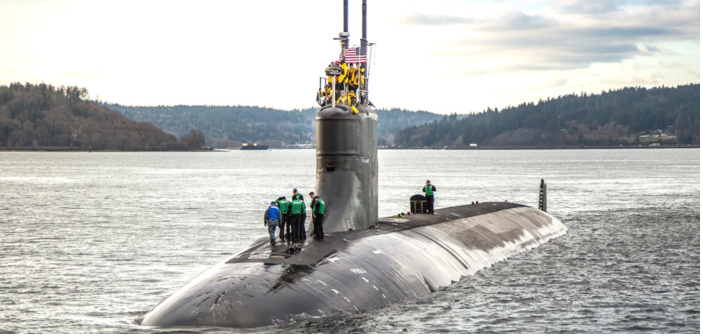The USS Connecticut, the Navy’s 353-foot-long, billion-dollar nuclear sub, arrived unannounced at San Diego earlier this week, completing a 6,000-mile journey on the surface from Guam.
The sub, with 15 officers and 101 enlisted personnel, cruised on the surface because it hit an underwater seamount on Oct. 2 in the South China Sea, ripping off the entire forward sonar dome and doing other unspecified damage (although the nuclear reactor was not involved). It could no longer safely travel underwater, and it cruised on the surface for a week to reach a repair facility in Guam.
Here’s a story from The Drive telling what the trip from Guam to San Diego was like for the crew. It wasn’t fun:
The U.S. Navy’s damaged nuclear fast-attack submarine USS Connecticut (SSN-22) made a secretive journey from Guam to San Diego over the last few weeks, with the submarine arriving unannounced in San Diego harbor on the morning of Dec. 12, 2021. The voyage was likely incredibly uncomfortable and fraught with danger. To give us a better idea of the risks involved and what this ordeal would have been like for Connecticut’s crew, we talked to our friend and veteran submariner Aaron Amick who spent 20 years on submarines as a Sonarman and now runs the excellent website Sub Brief that covers all matters regarding submarines and naval warfare.
A little background first. The Seawolf class submarine, of which there are only three in existence, slammed into an underwater seamount on Oct. 2, 2021, in the South China Sea and subsequently limped its way to Guam where the damage was assessed. While the full extent of the damage is unknown, the boat’s entire forward sonar dome was ripped off as a result of the impact. Connecticut will now need major repairs, likely spending years in dry dock, in order to return to sea, if indeed she is able to do so. Still, just getting her to a place where she can receive this level of attention was a major undertaking, with the stricken sub traveling over 6,000 miles in what would have been a marathon in endurance for her crew, the leadership of which was quickly replaced following the accident.
So with that background in mind, here is our exchange:
Yes. I think they transited on the surface, with at least one support vessel, at an average speed of 10 knots.
What is it like traveling in a submarine while it is surfaced? What does it feel like in different sea conditions?
A submarine on the surface is constantly rolling side-to-side even in the calmest of seas. It would have induced ‘sea sickness’ to those susceptible. If the rolls were large enough, it would have been tough to move or even sleep in a bunk. Most bunks have a towel rack, I have had to hook my forearm into it to help keep from being tossed out onto the deck in rough seas.
The lack of sleep, or what little sleep the sailors got, probably led to a lot of fatigue after the first few days of the over 20-day journey. Feeling seasick and exhausted is not ideal for watchstanding. It’s likely they implemented a flexible or augmented watch rotation for anyone who could not complete their watch. Read more:




